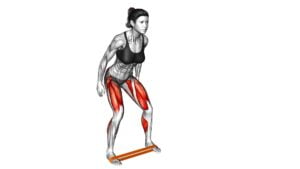Resistance Band Lateral Walk (male) – Video Exercise Guide & Tips

Are you looking for an effective exercise to strengthen your lower body? Look no further than the resistance band lateral walk!
Watch This Exercise Video
This video exercise guide and tips will show you how to properly perform this exercise, targeting your glutes, hips, and thighs.
With variations for male athletes and expert tips to maximize effectiveness, you'll learn everything you need to know to incorporate the resistance band lateral walk into your workout routine.
Get ready to take your fitness to the next level!
Key Takeaways
- Resistance Band Lateral Walk targets muscles in the lower body and strengthens glutes, hips, and thighs.
- It improves stability, balance, and athletic performance while reducing the risk of injury.
- Progression and variation can be achieved by increasing resistance, performing on an unstable surface, varying speed and distance, and adding different exercises.
- Proper form and technique involve placing the resistance band around the ankles, warming up properly, maintaining a slight bend in the knees, engaging the core, and stepping to the side with a widened stance.
Benefits of Resistance Band Lateral Walk for Males
You can experience numerous benefits from incorporating resistance band lateral walks into your exercise routine as a male. Not only do these exercises target the muscles in your lower body, but they also help improve your overall stability and balance. By engaging your glutes, hips, and thighs, resistance band lateral walks can help strengthen these muscle groups, leading to enhanced athletic performance and reduced risk of injury.
One of the key benefits of resistance band lateral walks for males is the activation of the gluteus medius muscle. This muscle plays a crucial role in stabilizing the hips and pelvis, and by strengthening it, you can improve your ability to perform dynamic movements such as running, jumping, and changing directions quickly.
To progress in resistance band lateral walks, you can increase the resistance of the band or perform the exercise on an unstable surface, such as a Bosu ball. This challenges your muscles even further and helps to develop greater strength and stability. Additionally, you can vary the speed and distance of your lateral walks to add variety and continue challenging your muscles.
Incorporating resistance band lateral walks into your exercise routine as a male can bring about significant improvements in lower body strength, stability, and overall athletic performance. So grab a resistance band and start reaping the benefits today!
Proper Form and Technique for Resistance Band Lateral Walk
To perform the Resistance Band Lateral Walk exercise with proper form and technique, begin by placing the resistance band around your ankles. This exercise isn't only beneficial for males but also for females. The resistance band lateral walk targets the muscles in your hips, glutes, and thighs, helping to improve lower body strength and stability. It also activates the abductor muscles, which are responsible for moving your legs away from the midline of your body. This can help to improve hip mobility and prevent injuries.
Before starting the resistance band lateral walk, it's important to warm up properly. Engaging in a dynamic warm-up routine that includes exercises like leg swings, hip circles, and bodyweight squats can help to prepare your muscles for the lateral walk. This will increase blood flow to the working muscles, improve joint mobility, and reduce the risk of injury.
To perform the exercise, stand with your feet hip-width apart and maintain a slight bend in your knees. Keep your core engaged and chest lifted. Take a step to the side, widening your stance, and then bring the other foot in to meet it. Continue stepping sideways, maintaining tension in the resistance band throughout the movement. Aim to keep your feet parallel throughout the exercise and avoid letting your knees collapse inward. Perform the exercise for the desired number of repetitions or time. Remember to maintain proper form and technique throughout.
Variations of Resistance Band Lateral Walk for Male Athletes
Now let's explore some variations of the Resistance Band Lateral Walk that male athletes can incorporate into their training routine. These variations will help to target different muscle groups and add variety to the exercise.
One variation is the Resistance Band Lateral Walk with a squat. Begin by placing the resistance band around your ankles and assume a squat position. As you step sideways, maintain the squat position, keeping your knees bent and your back straight. This variation not only targets the glutes and outer thighs but also engages the quadriceps and hamstrings.
Another variation is the Resistance Band Lateral Walk with a shoulder press. Start by standing with your feet shoulder-width apart and the resistance band looped around your wrists. As you step sideways, perform a shoulder press by extending your arms overhead. This variation not only strengthens the lower body but also engages the shoulders and upper back.
By incorporating these variations into your resistance band lateral walk routine, you can challenge your muscles in different ways and enhance your overall athletic performance.
Now, let's move on to the next section to learn some tips on how to maximize the effectiveness of the resistance band lateral walk.
Tips to Maximize the Effectiveness of Resistance Band Lateral Walk
To maximize the effectiveness of the resistance band lateral walk, it's crucial to maintain proper form techniques. This includes:
- Keeping your feet hip-width apart
- Maintaining tension in the resistance band throughout the exercise
- Engaging your core muscles
Additionally, choosing the correct resistance level is essential to ensure that you're challenging your muscles without compromising your form.
Proper Form Techniques
Ensure proper form during the Resistance Band Lateral Walk by maintaining a stable and controlled stance. To maximize the effectiveness of this exercise, it's important to avoid common mistakes and focus on proper technique.
One common mistake is allowing the knees to collapse inward, which can put unnecessary stress on the joints and reduce the effectiveness of the exercise. Instead, keep your knees in line with your toes throughout the movement.
Another mistake is rushing through the exercise without maintaining tension in the resistance band. To maximize effectiveness, take slow and controlled steps, maintaining constant tension on the band.
Additionally, engage your core and glutes throughout the exercise to ensure proper activation of the targeted muscles. By maintaining proper form and technique, you can achieve optimal results from the Resistance Band Lateral Walk.
Transitioning into the next section, let's now discuss the importance of choosing the correct resistance level.
Choosing Correct Resistance Level
To maximize the effectiveness of the Resistance Band Lateral Walk, here are some tips to help you choose the right resistance band for this exercise:
- Consider your fitness level: If you're new to resistance training, start with a lighter band and gradually increase the resistance as you get stronger.
- Look for different resistance levels: Resistance bands come in various levels of resistance, typically categorized by color. Choose a band that provides enough resistance to challenge your muscles.
- Consider the exercise: For the Resistance Band Lateral Walk, you'll need a band that allows you to maintain proper form throughout the movement. Make sure the band is long enough to provide adequate tension.
- Consult a fitness professional: If you're unsure about which resistance band to choose, seek guidance from a fitness professional who can assess your needs and recommend the appropriate resistance level.
- Enjoy the benefits: Resistance bands offer a range of benefits, including improving strength, flexibility, and stability. Choosing the right resistance band will help you maximize these benefits and enhance your overall workout experience.
Common Mistakes to Avoid During Resistance Band Lateral Walk
When performing the resistance band lateral walk, there are two common mistakes to avoid.
First, make sure to prevent your knees from collapsing inward, as this can put unnecessary strain on your joints and decrease the effectiveness of the exercise.
Second, ensure that the band is placed correctly around your ankles to maintain proper tension and target the intended muscles.
Knee Collapsing Inward
Avoid Knee Collapsing Inward during the Resistance Band Lateral Walk to maintain proper form and prevent injury. Proper knee alignment is crucial during this exercise to ensure optimal muscle engagement and prevent strain on the joints.
Here are some important tips to avoid knee collapsing inward:
- Keep your knees in line with your toes throughout the exercise.
- Engage your glutes and core muscles to stabilize your hips.
- Maintain a slight bend in your knees to avoid locking them out.
- Avoid excessive inward or outward movement of your knees.
- Use a resistance band with appropriate tension to challenge your muscles without compromising form.
By following these guidelines, you can enhance the effectiveness of the Resistance Band Lateral Walk while minimizing the risk of knee injuries.
Remember to prioritize proper knee alignment for injury prevention and optimal results.
Incorrect Band Placement
Ensure proper placement of the resistance band for the Resistance Band Lateral Walk to maximize effectiveness and avoid common mistakes.
Band placement errors can greatly impact the effectiveness of this exercise. One common band placement mistake is positioning the band too low on your legs. When the band is too low, it can cause excessive tension on the knees and lead to improper form.
Another mistake is placing the band too high, near the waist. This can limit the range of motion and prevent you from fully engaging the glute muscles.
To avoid these errors, place the band just above the ankles. This placement allows for proper alignment and ensures that the muscles targeted by the exercise are properly engaged.
Incorporating Resistance Band Lateral Walk Into Your Workout Routine
To maximize your workout routine, incorporate the resistance band lateral walk into your exercises for a more effective and targeted workout. The resistance band lateral walk is a versatile exercise that targets the muscles in your hips, glutes, and thighs. Here are some reasons why you should consider incorporating this exercise into your routine:
- Increased muscle activation: The resistance band adds external resistance, forcing your muscles to work harder. This leads to increased muscle activation, helping you build strength and tone in your lower body.
- Improved stability and balance: The lateral movement challenges your stability and balance, engaging the smaller stabilizer muscles in your hips and thighs. This can help improve your overall balance and reduce the risk of injuries.
- Enhanced hip mobility: The lateral walk requires you to move laterally, which helps improve hip mobility. This can be especially beneficial for athletes who need to move quickly and change direction.
- Added challenge to traditional exercises: Incorporating resistance bands into your routine can add an extra challenge to exercises like squats and lunges. This can help you break through plateaus and continue making progress.
- Convenient and portable: Resistance bands are lightweight and portable, making them a convenient tool for working out anywhere. You can easily incorporate the lateral walk into your routine, whether you're at the gym, at home, or on the go.
Frequently Asked Questions
How Long Should I Perform the Resistance Band Lateral Walk Exercise?
To get the most out of the resistance band lateral walk exercise, it's important to know how long to perform it.
The duration of the exercise depends on your fitness goals and current level of strength and endurance. Generally, aim for 2-3 sets of 10-15 steps in each direction.
This exercise targets your glutes, hips, and thighs, helping to improve lower body strength and stability.
Variations of the resistance band lateral walk can include using different resistance levels or incorporating other exercises for a well-rounded workout.
Can Resistance Band Lateral Walk Help Improve My Speed and Agility?
Resistance band lateral walk is a great exercise for improving quickness and agility. By incorporating lateral movements into your workout routine, you can enhance your speed and overall athletic performance.
The resistance band adds extra resistance, challenging your muscles to work harder and increasing the effectiveness of the exercise. This exercise targets the muscles in your hips, glutes, and thighs, which are essential for explosive movements and quick changes in direction.
Incorporating resistance band lateral walks into your training can have significant benefits for your speed and agility.
Are There Any Specific Warm-Up Exercises I Should Do Before Performing the Resistance Band Lateral Walk?
Before performing the resistance band lateral walk, it's recommended to do specific warm-up exercises. These exercises can help prepare your muscles and joints for the movement and reduce the risk of injury.
Some examples of warm-up exercises include dynamic stretches, such as leg swings and hip circles, as well as activation exercises, like glute bridges and lateral lunges.
Incorporating these warm-up exercises can enhance the benefits of the resistance band lateral walk and improve your overall performance.
Can Resistance Band Lateral Walk Help With Knee Stability and Injury Prevention?
Resistance band lateral walks can be beneficial for knee stability and injury prevention. By engaging the muscles around your knees, this exercise helps strengthen the knee joint and improve overall stability.
The resistance band adds an extra challenge, increasing muscle activation and promoting proper alignment. Incorporating resistance band lateral walks into your workout routine can be an effective way to target the muscles around your knees and reduce the risk of injuries.
Can I Perform the Resistance Band Lateral Walk Exercise Without a Resistance Band?
Yes, you can perform the resistance band lateral walk exercise without a resistance band. However, using a resistance band provides added benefits such as increased resistance and targeted muscle activation.
Resistance band alternatives like ankle weights or resistance tubes can be used as substitutes.
The resistance band lateral walk exercise helps improve hip and glute strength, stability, and overall lower body function. It's an effective exercise for injury prevention and enhancing athletic performance.
Conclusion
In conclusion, the Resistance Band Lateral Walk is a highly effective exercise for male athletes. It helps to strengthen the muscles in the hips, glutes, and legs, improving overall stability and power.
By maintaining proper form and technique, varying the exercise intensity, and incorporating it into a regular workout routine, males can maximize the benefits of the Resistance Band Lateral Walk.
Avoiding common mistakes and following the provided tips will ensure optimal results and reduce the risk of injury.

Author
Years ago, the spark of my life’s passion ignited in my mind the moment I stepped into the local gym for the first time. The inaugural bead of perspiration, the initial endeavor, the very first surge of endorphins, and a sense of pride that washed over me post-workout marked the beginning of my deep-seated interest in strength sports, fitness, and sports nutrition. This very curiosity blossomed rapidly into a profound fascination, propelling me to earn a Master’s degree in Physical Education from the Academy of Physical Education in Krakow, followed by a Sports Manager diploma from the Jagiellonian University. My journey of growth led me to gain more specialized qualifications, such as being a certified personal trainer with a focus on sports dietetics, a lifeguard, and an instructor for wellness and corrective gymnastics. Theoretical knowledge paired seamlessly with practical experience, reinforcing my belief that the transformation of individuals under my guidance was also a reflection of my personal growth. This belief holds true even today. Each day, I strive to push the boundaries and explore new realms. These realms gently elevate me to greater heights. The unique combination of passion for my field and the continuous quest for growth fuels my drive to break new ground.







